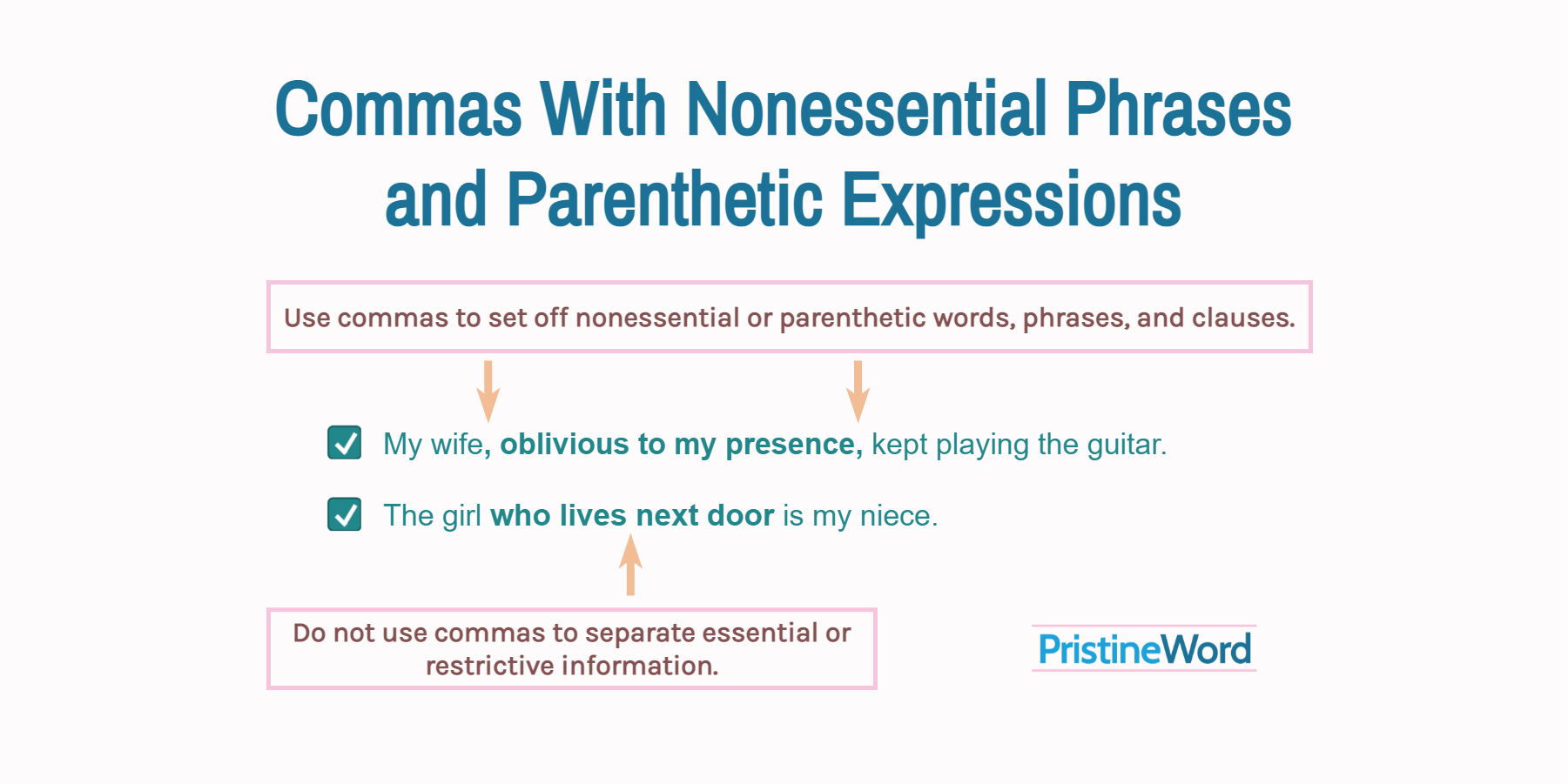Use commas to set off parenthetic expressions and nonessential words, phrases, or clauses. Do not use commas to separate essential or restrictive information.
Use commas to set off parenthetic expressions and nonessential words, phrases, or clauses.
My wife, oblivious to my presence, kept playing the guitar.
My wife oblivious to my presence kept playing the guitar.
Do not use commas to separate essential or restrictive information.
The girl who lives next door is my niece.
The girl, who lives next door, is my niece.
Contents
1. What is a Nonessential Phrase or Parenthetic Expression?
A nonessential word or phrase provides additional information, but it can be easily removed without changing the meaning of the sentence.
Michelle, knowing it was late, hurried back home.
The phrase "Knowing it was late" helps readers accurately interpret the sentence above; however, this information is not essential. It can be safely omitted without changing the meaning of the main statement ("Michelle hurried back home.")
We can also use the term parenthetic expression to refer to nonessential words or phrases. In fact, we frequently use parentheses (instead of commas) to set off expressions that help clarify or can be used as an aside.
Mark finally said (after taking two minutes to think) that something was wrong.
Similarly, nonrestrictive clauses are parenthetic or nonessential. A nonrestrictive clause is one that does not define, limit, or identify a noun; they simply add something. Therefore, they must be placed between commas.
My girlfriend, who is very talented, has been promoted to the position of chief technology officer.
My girlfriend who is very talented has been promoted to the position of chief technology officer.
Another example:
Ashley, my best friend, helped make this day happen.
Restrictive clauses, by contrast, are essential and must not be surrounded by commas.
People who live in Norway are used to cold weather.
People, who live in Norway, are used to cold weather.
2. Place Parenthetic Expressions Between Commas
Nonessential words, clauses, or phrases that appear in the middle of a sentence must be placed between commas.
The long book, most of which was boring, made me fall asleep.
The long book most of which was boring made me fall asleep.
If the parenthetic expression comes at the start of a sentence, add a comma after the introductory phrase.
Knowing it was late, Patricia hurried back home.
At the end of a sentence, nonessential phrases and words should be preceded by a comma and followed by a period.
She decided to accept the challenge and fight, oblivious of her safety.
Dates commonly contain parenthetic figures or words; consequently, we punctuate dates as follows:
The meeting was held on October 22, 2021.
I went to New York on Tuesday, November 17, 2020.
No comma is necessary for just the month and the year.
They moved to Miami in March 2021.
Enclose names between commas when speaking to someone directly.
Well, Richard, I need to talk to you about something.
But do not use commas to talk about someone.
Your friend Rebecca has a new boyfriend.
Abbreviations such as "etc.", "e.g.", and "i.e." should be enclosed by commas since they are parenthetic as well.
Some sports, e.g., bull riding and rugby, are dangerous.
3. What is an Appositive Comma?
As mentioned above, nonessential expressions in mid-sentence should be surrounded by commas. The closing comma of a parenthetic expression or nonessential phrase is called an appositive comma. Some writers forget to place this important comma.
Agatha Christie, all of whose books are exciting, wrote 66 detective novels.
Agatha Christie, all of whose books are exciting wrote 66 detective novels.
Another example:
My three best friends, Mary, Jennifer, and David, are working abroad.
My three best friends, Mary, Jennifer, and David are working abroad.
Regarding the appositive comma, the American writing style guide "The Elements of Style" says:
❝ ...But whether the interruption is slight or considerable, never omit one comma and leave the other. There is no defense for such punctuation... ❞
Strunk JR., William; White, E.B.. The Elements of Style, Fourth Edition.(1)
4. Essential (Restrictive) vs. Nonessential
Determining whether a phrase is or is not essential may be challenging. If the interruption to the sentence flow is but slight, the commas may be safely omitted.(1) In contrast, if someone or something is sufficiently identified, the description that follows is considered parenthetic and should be enclosed by commas.
My friend Rebecca, who lives next door, loves painting.
Alfred Hitchcock, all of whose movies are exciting, was a great film director.
Do not use commas, though, if the description is restrictive or necessary to identify the subject or the object.
The girl who lives next door loves painting.
The girl, who lives next door, loves painting.
Recommended: When to Use a comma before "who", "which", and "that"
Examine this example:
My sister Carol is studying to be a lawyer.
Without commas, "Carol" is essential information, necessary to identify the subject. Therefore, the sentence above means that I have more than one sister.
Conversely, if I had only one sister, the name "Carol" would be nonessential.
My sister, Carol, is studying to be a lawyer.
Simply put, do not use commas if the description defines or limits the antecedent noun.
The man who was arrested with the money is German.
The man, who was arrested with the money, is German.
"Who was arrested with the money" is restrictive because it helps identify the man we are talking about.
5. References
(1) Strunk JR., William; White, E.B. The Elements of Style. Chapter 1 - Elementary Rules of Usage.

